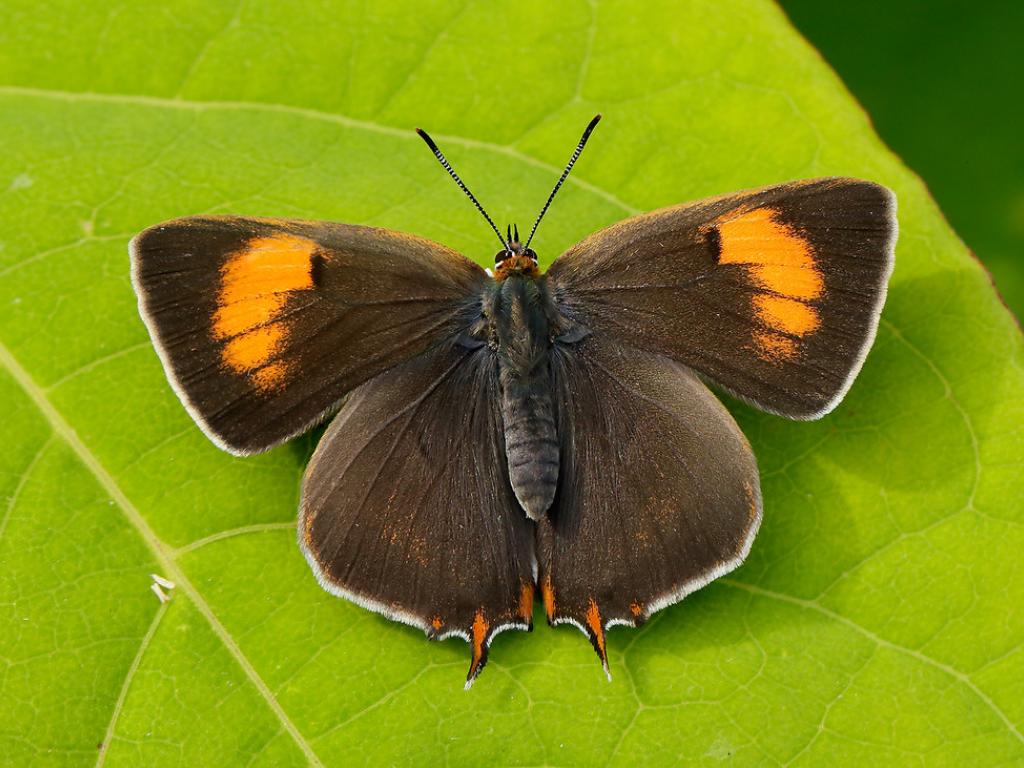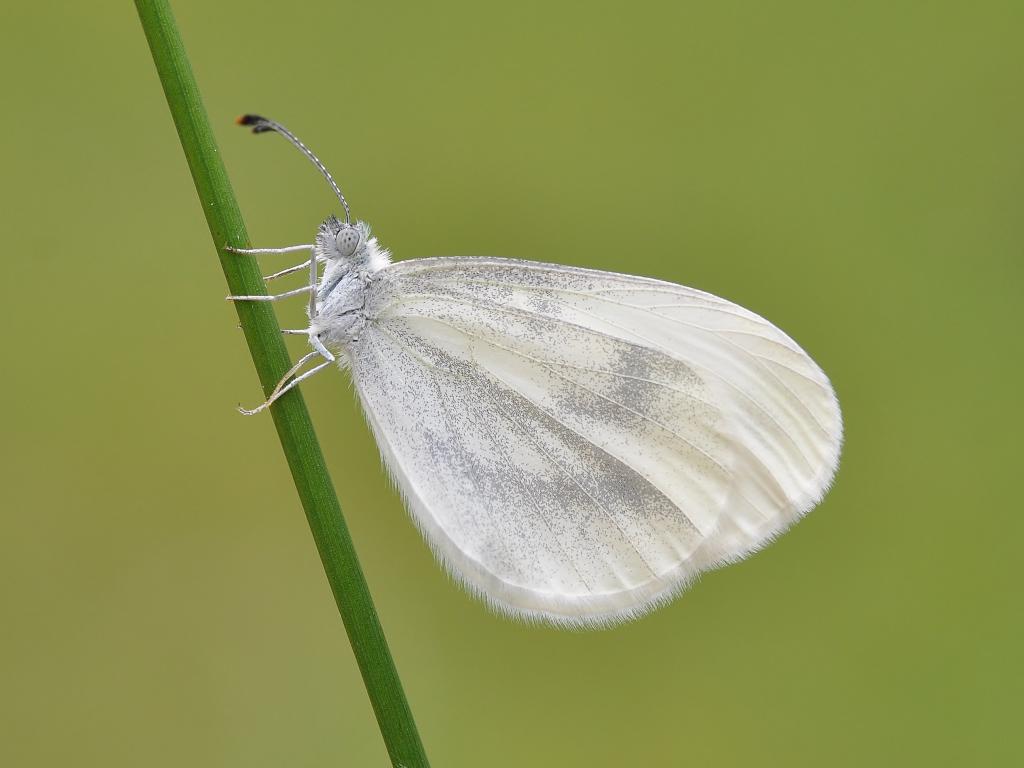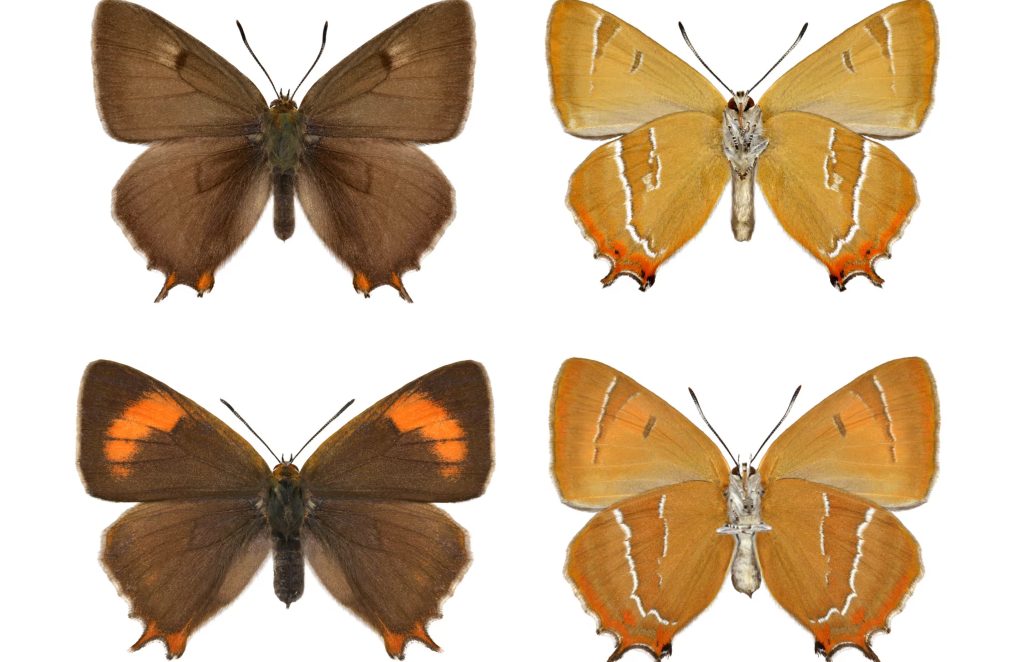
It is worth looking up at prominent Ash trees along wood edges to see if small clusters of adults may be flitting around. They congregate to mate and feed on aphid honeydew. Adults also sometimes feed lower down on flowers such as Hemp-agrimony, Common Fleabane and Bramble. The females are most frequently seen as they disperse widely along hedgerows where they lay conspicuous white eggs on young Blackthorn shoots.
The butterfly often rests with its wings closed showing orange-brown underwings with two wavy white streaks and small tails. Uppersides are brown with an orange mark.
It is locally distributed in southern Britain and mid-west Ireland and has undergone a substantial decline due to hedgerow removal and annual flailing, which removes eggs.
Size and Family
- Family: Hairstreaks
- Size: Small/Medium
- Wing Span Range (male to female): 38-40mm
Conservation status
- Section 41 species of principal importance under the NERC Act in England
- Section 7 species of principle importance under the Environment (Wales) Act 2016
- UK BAP status: Priority Species
- Butterfly Conservation priority: High
- European Status: Not threatened
- Protected under Schedule 5 of the 1981 Wildlife and Countryside Act (for sale only)
Caterpillar Foodplants
The Butterfly breeds on the young growth of Blackthorn (Prunus spinosa) and occasionally other Prunus species such as Bullace (P. domestica).
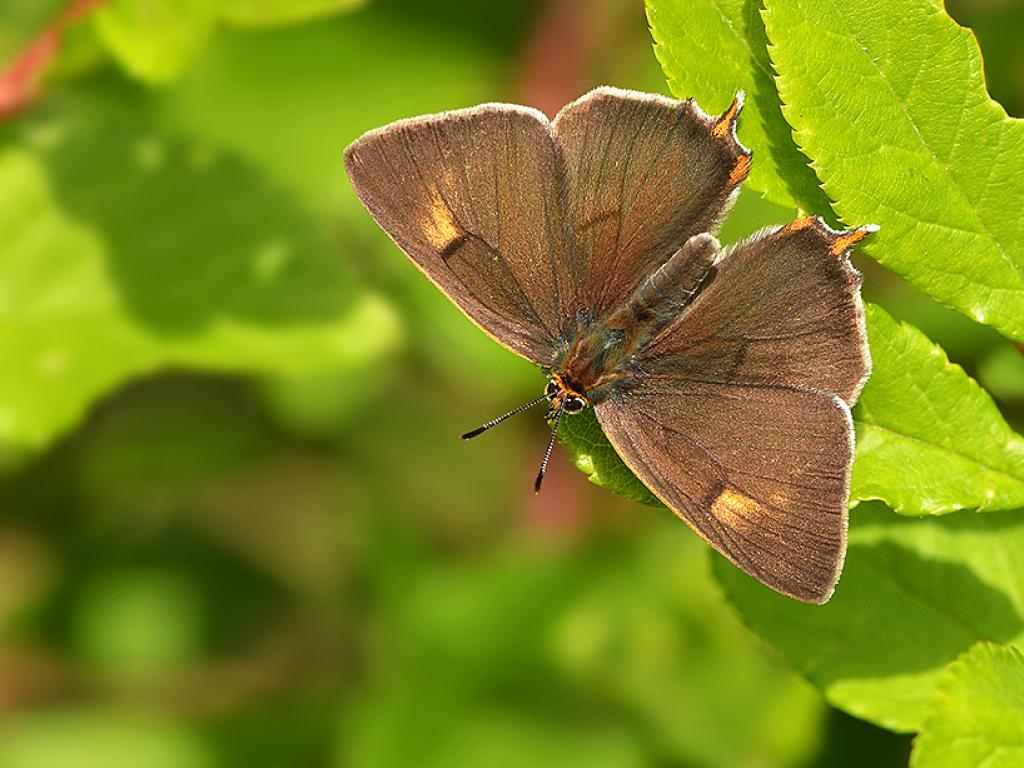
Lifecycle

Habitat
Hedges, scrub and woodland edge where Blackthorn is prominent and not flailed every year.
- Habitat: Hedges and woodland edges which extend across a wide area.
- Caterpillar foodplants: Mainly Blackthorn, occasionally other Prunus species.
- Best places: The only place you are fairly certain to see the Brown Hairstreak in Dorset (at the right time) is at our Alners Gorse Butterfly Reserve. They have been reported at Lydlinch, also in North Dorset.
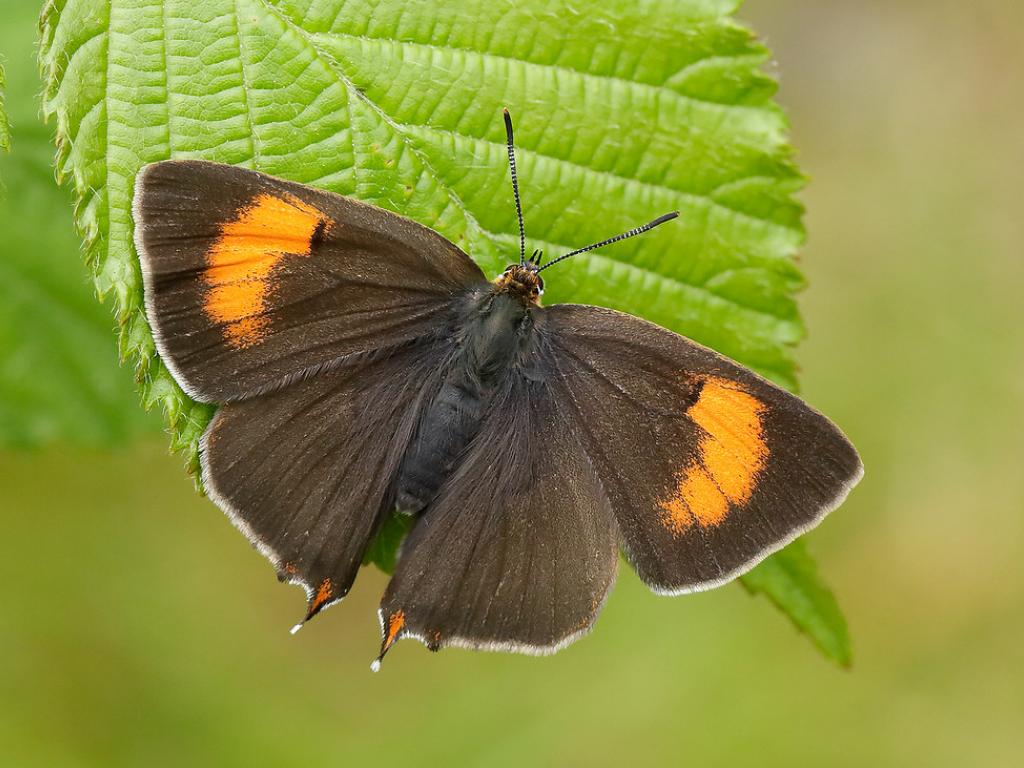
Distribution
- Countries: England, Wales, and Ireland
- Restricted in the UK to three main centres: south-west Wales, Devon/Somerset and Surrey/Sussex. Other smaller populations occur around Oxford and on Salisbury Plain.
- Distribution Trend Since 1970’s = -49%.
Brown Hairstreak Obsession
The Brown Hairstreak is one of our most elusive yet most conspicuous butterflies. The adult is rarely seen but the egg is easily found.
It is an attractive butterfly, the female especially delightful with a warm golden underside with a patch of the same striking hue on the upper-side of the fore-wings. Aside from the golden patch the upper-sides are dark brown. Males look similar, but the underside gold is paler and the fore-wing patch paler and reduced or absent. The reddish-gold tails on the hind-wings add to its charms. The legs are a striking white, resembling starched white sport socks.
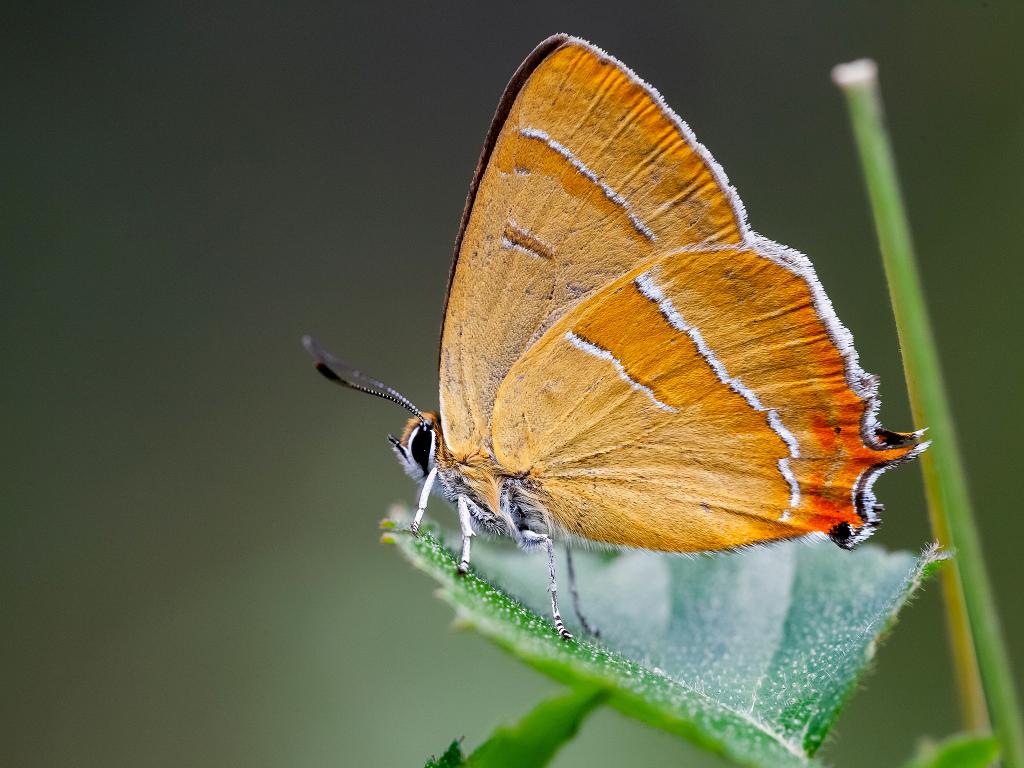
The Brown Hairstreak is the largest hairstreak in Ireland and is not common here or in Britain (we have three hairstreaks; the Green Hairstreak and Purple Hairstreak are the others). In Ireland it is mainly found in the Burren in Clare and Galway, with a small population in west Tipperary and west of Lough Corrib, County Galway. In Britain it is mainly found further south, in south-west Wales, southern, south-west and south central England with a small population in the east, in Lincolnshire.
Brown Hairstreak in Sussex
The Brown Hairstreak is our largest hairstreak species. It’s very beautiful but very elusive. The males and females are slightly different in coloration – indeed they were once thought to be different species.
West Sussex is a stronghold for this species and the adults are on the wing from late July. It is often seen by chance but it is also a challenge for the enthusiast to track down. Observation takes a degree of patience and footwork, but can offer great rewards, as it’s a beautiful butterfly. Being elusive it’s difficult to determine significant changes in numbers from year to year apart from perhaps by undertaking detailed winter egg counts. The Brown Hairstreak overwinters in the egg stage. Eggs are predominately laid on Blackthorn and also Wild Plum in August and September. On Blackthorn the white pin-sized eggs are relatively easy to see.
They are normally laid singularly but occasional two or more can be seen at the base of young twigs on the bark on protruding Blackthorn shoots or suckering Blackthorn at the base of hedges. They prefer a sheltered site and a sunny south facing aspect, especially if Ash trees are in the vicinity. The eggs hatch in late April or early May to coincide with the opening of buds and leaves on which they feed .The caterpillar is well camouflaged, resembling the underside of a leaf midrib. Although I have seen early instars active in the day, the later instar caterpillars are most active while feeding at night; in the day they can be found at rest by a leaf midrib.
The caterpillars pupate close to the ground in leaf litter in early July and it’s believed the pupa is tended by ants. The adults emerge in late July, probably in the early morning, and the males are known to occupy “master trees” where they will fight with each other. I have observed males on the wing patrolling in trees from 7.49am to after 4.00pm in warm conditions. I have also watched males feeding on a secretion from Ash buds, and females are regularly seen nectaring on Brambles, thistles and Fleabane.
It’s suspected the males emerge first, followed by the females. Females are generally active after 11.00am when they come down to egg lay but probably cease egg laying around 3.00pm. After mating the female spends time sunbathing which allows the eggs to mature and for this reason can be difficult to spot. However, egg laying is readily observed and is a fascinating spectacle. The female descends a shoot, sometimes spiralling, to find a suitable egg laying location.
In 2000 Neil Hulme discovered an excellent site at Steyning Rifle Range where The Steyning Downland Scheme now maintain a fenced Brown Hairstreak “reserve”. Blackthorn and Wild Plum are cut on a rotational basis to provide an ideal egg laying site where young growth, preferred by the Brown Hairstreak, is maintained year on year. There is an annual Brown Hairstreak walk in late August when the Brown Hairstreak can be seen, so long as it’s not raining or too windy. They can be seen here and in many other places across West Sussex in warm sunny conditions. The greatest predation is probably of the pupa by small mammals however it is well known that hedge cutting will remove over 95% of eggs laid and is perhaps the greatest annual threat. Brown Hairstreaks live in discreet colonies which can last for many years.

